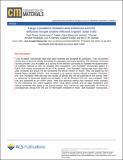Large crystalline domains and enhanced exciton diffusion length enable efficient organic solar cells
Abstract
We studied crystallinity and exciton harvesting in bulk heterojunctions of a semiconducting polymer PffBT4T-2OD and electron acceptor PC71BM which are used to make highly efficient organic solar cells. Grazing incidence wide-angle X-ray scattering (GIWAXS) shows that the size of crystalline domains of PffBT4T-2OD increases to ~18 nm in photovoltaic blends upon thermal annealing at 100 °C for 5 minutes. These domains are larger than the typical exciton diffusion lengths in conjugated polymers. Time-resolved fluorescence measurements show that exciton diffusion length in PffBT4T-2OD increases from ~14 to ~24 nm upon thermal annealing, which enables efficient charge generation in blends with large domains. Solar cells prepared using thermally annealed blends show higher photocurrent, open circuit voltage and fill factor compared to as spin-coated blends which indicates reduced recombination losses. Our results demonstrate the advantages of large crystalline domains in organic photovoltaics, providing exciton diffusion is sufficient.
Citation
Zhang , Y , Sajjad , M T , Blaszczyk , O , Parnell , A J , Ruseckas , A , Serrano , L A , Cooke , G & Samuel , I D W 2019 , ' Large crystalline domains and enhanced exciton diffusion length enable efficient organic solar cells ' , Chemistry of Materials , vol. 31 , no. 17 , pp. 6548-6557 . https://doi.org/10.1021/acs.chemmater.8b05293
Publication
Chemistry of Materials
Status
Peer reviewed
ISSN
0897-4756Type
Journal article
Description
The authors thank the European Research Council for financial support (EXCITON Grant 321305).Collections
Items in the St Andrews Research Repository are protected by copyright, with all rights reserved, unless otherwise indicated.

